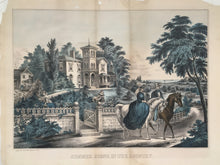Unattributed. "Summer Scene in the Country."
Philadelphia: Jos. Hoover, ca. 1870. 17 x 24. Lithograph. Original hand color. Wide margins. Some chips at edges, not affecting image. Professionally conserved and lined. Else, very good condition.
Joseph Hoover started by his career making elaborate wood frames in Philadelphia in 1856, but within a decade or so he began to produce popular prints. Initially he mostly worked for other publishers, including Duval & Hunter, but he also issued a number of hand-colored, popular prints. During the Centennial, Hoover won a medal for excellence for his chromolithographs after James F. Queen's renderings.
Popular decorative lithographs made their first American appearance in the 1820s, but by the middle of the century, lithography had transformed the role of art in America. Before the advent of lithography in America, the general public had little art in their lives. Prints intended for display, produced by woodcut or engraving, had a long history, but these prints were generally expensive and limited in distribution to the social elite. Lithography allowed for the production, in large numbers, of inexpensive and often colorful prints which could be purchased by the general public for display in their homes, at work, and in their places of leisure. By the second half of the century, many homes, taverns, shops, and offices were decorated with these cheap and colorful prints on myriad subjects of interest to the public. Whereas at the beginning of the century most Americans had little access to art in their life, by the end of the century, popular art was ubiquitous in the lives of most Americans.





